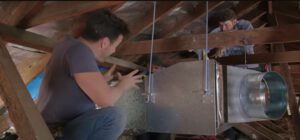One of the biggest questions homeowners in Australia have when it comes to roofing is whether they can install a roof-mounted air conditioning unit. Homeowners in Australia are fortunate to have access to efficient and effective air conditioning systems. This makes them a viable option for homeowners who want to take advantage of the comfort that air conditioning provides.
What are the benefits of installing a roof-mounted air conditioning unit?
There’re many benefits to installing a roof-mounted air conditioning unit. These include:
Improved Comfort
Installing a roof-mounted air conditioning unit will ensure you experience improved comfort levels inside your home, no matter the temperature outside. This is especially beneficial during the long hot summers in Australia.
Cost Savings
A roof-mounted air conditioning unit can help to reduce your energy bills as they are more efficient than traditional air conditioning systems. They also use less power and require minimal maintenance, leading to long-term cost savings.
Environmental Considerations
Installing a roof-mounted air conditioning system can reduce the amount of electricity being used in your home, thus helping to reduce your carbon footprint. Additionally, the system can help to reduce noise pollution as it runs more efficiently than traditional air conditioning systems.
Ease of Installation
Installing a roof-mounted air conditioning system is relatively straightforward. The main parts are typically pre-fabricated and designed to fit the exact dimensions of your roof, making installation easy. Additionally, since all of the components are on the roof, you won’t need to worry about clearing space inside your home for bulky equipment or lengthy ductwork.
Cost-effectiveness
 While the upfront cost of installing a roof-mounted air conditioning system is more expensive than traditional systems, they are more cost-effective in the long run. The lack of ductwork helps to reduce installation costs and ongoing maintenance is relatively affordable since all components are accessible from the roof. Additionally, many states offer tax credits or other incentives for installing energy-efficient systems, so you could potentially save money when you file your taxes.
While the upfront cost of installing a roof-mounted air conditioning system is more expensive than traditional systems, they are more cost-effective in the long run. The lack of ductwork helps to reduce installation costs and ongoing maintenance is relatively affordable since all components are accessible from the roof. Additionally, many states offer tax credits or other incentives for installing energy-efficient systems, so you could potentially save money when you file your taxes.
Energy efficiency
Roof-mounted air conditioners are typically more energy efficient than traditional units since they don’t need to work as hard to cool a space. Additionally, their placement on the roof helps to ensure that cool air is circulated evenly throughout the building, as opposed to traditional units which are typically placed around windows or other openings to ensure that they’re getting enough airflow. This can help reduce energy costs and help keep your home cooler in the summer months.
Durability
Another major benefit of roof-mounted air conditioners is their extreme durability. The roof offers the unit protection from the elements and helps reduce wear and tear that can occur with traditional units due to their placement in direct sunlight or near other sources of moisture. Additionally, since they’re placed on the roof, they help reduce noise pollution by keeping any sound coming from the AC well away from your living space.
Legal Requirements For Installing Rooftop AC Units
Before you install a rooftop air conditioner, make sure to check with your local building codes and other regulations. Not all areas will allow the installation of these types of units due to zoning issues or safety concerns. Additionally, it’s important that the unit you are planning to install is properly sized and installed according to manufacturer’s instructions. If you attempt to install a larger unit than recommended, it could be dangerous and cause damage to the roof or other structures.
Installing Rooftop AC Units
When you are ready to install your new rooftop AC unit, call a professional roofing contractor to ensure the job is done properly. They will be able to advise you on what materials and tools are needed for the job, as well as how to safely install it without damaging your roof or other structures. The contractor may also be able to provide a warranty on their workmanship.
The first step in installation is mounting the unit on the roof. This can involve cutting a hole in the roof and attaching brackets and/or anchors to secure it. It is important to ensure that the hole is properly sealed with caulk or other sealant, as this will help keep moisture from entering the interior of your home.
Next, the contractor will need to connect the unit’s power cables to the existing electrical panel. It is important for the contractor to make sure that the system is properly wired and connected to a GFCI (ground fault circuit interrupter) outlet, which will protect you in case of an electrical short or surge.
Once the unit is securely mounted and wired up, it needs to be tested to ensure that it is running properly. This can be done by an HVAC technician, who will run the unit and check for any potential problems. After testing the system, the contractor should inspect it to make sure that there are no leaks or other issues.



